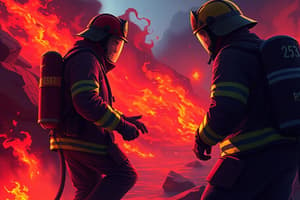Podcast
Questions and Answers
What is the primary purpose of the standard operating procedure outlined?
What is the primary purpose of the standard operating procedure outlined?
- To establish emergency contacts.
- To identify offensive operations. (correct)
- To document fire incidents.
- To train firefighters.
What should be done prior to initiating an offensive attack?
What should be done prior to initiating an offensive attack?
- Perform a 360 survey. (correct)
- Conduct a review of past incidents.
- Immediately apply water from the ground.
- Deploy backup units.
Which of the following methods should be avoided when dealing with passing fire?
Which of the following methods should be avoided when dealing with passing fire?
- Passing the fire without applying water. (correct)
- Applying water directly to the fire.
- Waiting for more resources.
- Using backup hoses.
What must the Incident Commander establish to effectively control fire?
What must the Incident Commander establish to effectively control fire?
What is essential for effective communication during operations?
What is essential for effective communication during operations?
What is the primary purpose of the property conservation procedure?
What is the primary purpose of the property conservation procedure?
What should be done immediately after determining the fire has been controlled?
What should be done immediately after determining the fire has been controlled?
Which of the following is NOT listed as a loss prevention activity by the Incident Commander?
Which of the following is NOT listed as a loss prevention activity by the Incident Commander?
What action should be taken when both fire control and salvage are necessary?
What action should be taken when both fire control and salvage are necessary?
What must the Incident Commander ensure regarding property conservation resources?
What must the Incident Commander ensure regarding property conservation resources?
What does the term 'Situation Contained' signify in a fire situation?
What does the term 'Situation Contained' signify in a fire situation?
What is the first priority during defensive operations?
What is the first priority during defensive operations?
When should personnel withdraw from a structure during a fire incident?
When should personnel withdraw from a structure during a fire incident?
What should be done after establishing exposure coverage during a fire incident?
What should be done after establishing exposure coverage during a fire incident?
What distinguishes the change from Offensive to Defensive Strategy from an Emergency Evacuation?
What distinguishes the change from Offensive to Defensive Strategy from an Emergency Evacuation?
What indicates a shift to Defensive Operations?
What indicates a shift to Defensive Operations?
Which situation is categorized as Defensive from the onset?
Which situation is categorized as Defensive from the onset?
What must the Incident Commander (I/C) do in a Defensive operation?
What must the Incident Commander (I/C) do in a Defensive operation?
When is a transition from Offensive to Defensive operations typically made?
When is a transition from Offensive to Defensive operations typically made?
Which of the following describes a key characteristic of Defensive operations?
Which of the following describes a key characteristic of Defensive operations?
What is the primary purpose of this fire control strategy procedure?
What is the primary purpose of this fire control strategy procedure?
Which factor is NOT considered when determining a fire control strategy?
Which factor is NOT considered when determining a fire control strategy?
What must the incident commander evaluate concerning risk before committing to a fire control strategy?
What must the incident commander evaluate concerning risk before committing to a fire control strategy?
What should be limited to situations with a potential to save endangered lives?
What should be limited to situations with a potential to save endangered lives?
According to the fire control strategies, what is the appropriate response when the risk to members is excessive?
According to the fire control strategies, what is the appropriate response when the risk to members is excessive?
Which of the following is a principle of risk analysis during emergency operations?
Which of the following is a principle of risk analysis during emergency operations?
What is one of the critical factors the Incident Commander must consider regarding fire dynamics?
What is one of the critical factors the Incident Commander must consider regarding fire dynamics?
Which aspect is NOT specified as a risk in the fire control strategy?
Which aspect is NOT specified as a risk in the fire control strategy?
What is the first step in the Offensive fire control strategy?
What is the first step in the Offensive fire control strategy?
Which step is included in the Defensive fire control strategy?
Which step is included in the Defensive fire control strategy?
When should a Defensive strategy be implemented?
When should a Defensive strategy be implemented?
What is the main focus of the initial steps in the Defensive strategy?
What is the main focus of the initial steps in the Defensive strategy?
Which statement is true about the Offensive strategy?
Which statement is true about the Offensive strategy?
Flashcards are hidden until you start studying
Study Notes
Fire Control Strategy
- The Incident Commander must determine the most appropriate fire control strategy.
- Risk assessment must be performed before committing to a strategy.
- Acceptable risk levels are directly proportional to the potential for saving lives/property.
- The risk should be evaluated based on the ability to save property when there is no potential to save lives.
- The risk analysis should be based on four principles to ensure member safety:
- Limit activities with significant risk to situations where saving lives is possible.
- Recognize activities for property protection as risks to members and take steps to manage them.
- No risk to members is acceptable when there is no possibility to save lives or property.
- Limit activities to defensive operations when the risk to members is excessive.
- Fire control strategies include offensive and defensive strategies.
- The offensive strategy involves interior fire attack with the goal of extinguishing the fire.
- The defensive strategy involves an exterior attack to reduce fire extension and bring it under control.
- Utilize defensive strategy when there is no way to save lives or property.
- Avoid exposing fire department members to avoidable risk.
Offensive Operations
- Offensive fire attack is the most common and important method, but focus should be on controlling ventilation openings and cooling fire gases.
- Conduct a 360 survey prior to offensive attack to determine whether first water should be applied from the exterior (transitional attack) or the interior (direct interior attack).
- Avoid passing fire without applying water.
- The Incident Commander must structure operations to apply water on the fire.
- Effective fire control requires direct water application to the fire.
- The Incident Commander should develop an Incident Action Plan (IAP) that includes:
- A fire attack plan.
- A search plan.
- Coordination of tactics.
Defensive Operations
- Defensive operations are employed when an offensive strategy is abandoned for reasons of personnel safety or inadequate resources.
- Defensive operations are categorized as either defensive from the onset or offensive to defensive.
- Defensive from the onset operations are for structures with advanced fire conditions or low value and/or high risk structures with advanced fire conditions and low life hazard.
- Offensive to defensive involves an offensive fire attack that fails to make progress or lacks resources.
- When operating defensively, the Incident Commander must announce a change in strategy over the Fireground All-Call Talkgroup and report to the fire alarm office.
- Withdraw all personnel from the structure and maintain a safe perimeter.
- Conduct a PAR (Public Address Response) according to SOP 02-01-01.
- Withdraw interior lines and reposition them to protect exposures.
- First priority is life safety, followed by exposure protection.
Situation Contained
- The standard radio term "Situation Contained" is used to report fire control.
- "Situation Contained" signifies the forward progress of the fire has been stopped and can be extinguished using on-scene resources; however, the fire is not out.
Property Conservation
- Property conservation strategy aims to minimize property loss during fire incidents.
- Property conservation requires the same early and on-going command functions and aggressive action as rescue and fire control.
- Shut off fire stream once the fire is out to minimize damage.
- Early recognition of fire stoppage is crucial for reducing losses.
- Commit and direct companies to loss prevention activities after basic fire control is achieved.
- Commit adequate resources to property conservation activities.
Studying That Suits You
Use AI to generate personalized quizzes and flashcards to suit your learning preferences.




